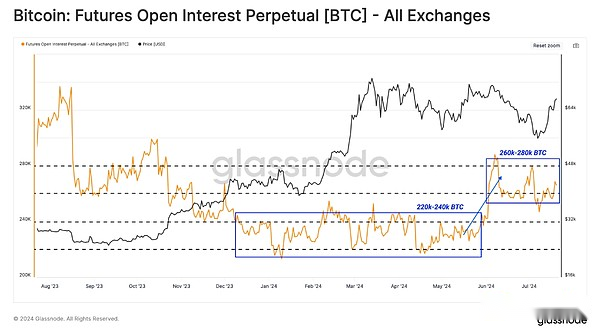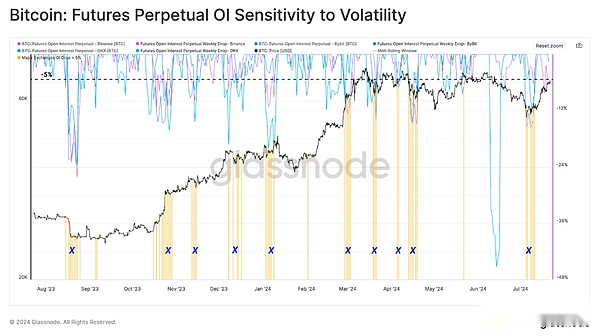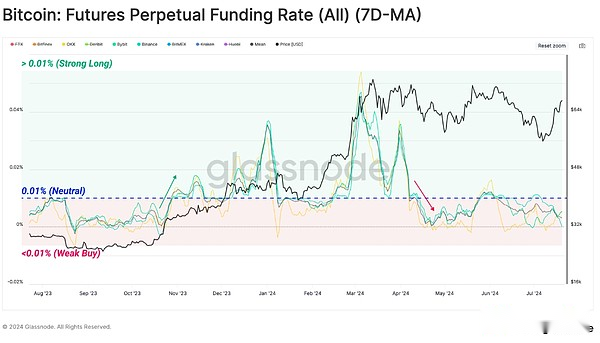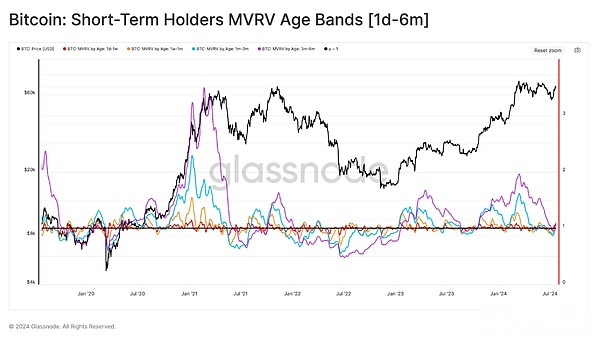
Author: CryptoVizArt, UkuriaOC, Glassnode; Compilation: Wuzhu, bitchain vision
summary
-
Binance, Bybit and OKX remain industry leaders in the perpetual swap market, accounting for about 84% of the total open contracts.
-
We have introduced a new model to track the sensitivity of futures market leverage and open contracts relative to changes in spot Bitcoin prices.
-
Prices have rebounded to a short-term holder cost basis, providing much-needed help for new investors, with more than 75% of supply being re-converted to profits.
Perpetual futures market
The perpetual futures market is the trading place with the deepest digital assets and the strongest liquidity.Trading volume is usually orders of magnitude higher than the spot market and is the preferred tool for executing trading, speculative positions and arbitrage strategies.
In this section, we aim to introduce a framework that leverages the perpetual futures market to identify market pivot points.It attempts to identify the point where excessive leverage speculators are liquidated during bull market adjustments.
In 2024, the open interest for perpetual futures is between 220,000 and 240,000 BTC.This value usually drops rapidly during deleveraging events and rises during more speculative periods.Recently, open interest has risen to the 260,000 to 280,000 BTC range, indicating a high speculative interest since early June.

To better understand the mechanisms of the perpetual contract market, we measured the share of the top three exchanges based on the open contract quantity.
As shown below, Binance, Bybit and OKX account for about 84% of the market share, so we will focus on the metrics related to these exchanges for analysis.

The turning point in the perpetual contract market often leads to a significant reduction in open contracts, which is usually a direct result of margin clearing for traders holding highly leveraged positions.
The chart below highlights the period when open interest on the top three exchanges fell by more than 5% in a week.We have encountered 10 such perpetual contract clearance incidents over the past 12 months.

To assess the size of the mandatory closing contract, we measured the total liquidation volume during these deleveraging events.The chart below shows that total liquidation volume (boths and shorts) soared above the typical bull market baseline of $200 million a day.This shows the role of margin clearing in the decline of open positions in the chart above.

Directional deviation
During market turmoil, deleveraging events may occur when the market moves in either direction.However, in this case, we specifically isolated potential pivot points during bull market adjustments, thus dividing the liquidation into two subsets:
-
Longs lead liquidation, with more than 50% of the liquidation positions belonging to longs in the contract (green)
-
Shorts lead liquidation, with more than 50% of the liquidation positions belonging to contract shorts (red)
In the recent selloff that dropped to $55,000, we can see a definite long liquidation candidate pivot point recorded.Here, excessively leveraged long positions were liquidated, resulting in a sharp decline in open positions on the top three perpetual futures exchanges.

Next, we can build a framework to discover these pivot points using perpetual contract financing rates.This approach takes advantage of the 7-day moving average of financing interest rates from the top three exchanges.
This is a very insightful indicator that provides information on position direction deviations in the perpetual contract market.When the weekly average of financing rates is above the neutral level (0.01% every 8 hours), it indicates that market recipients have a high demand for opening long positions.
Demand for long positions in the perpetual contract market has been weakening after the current ATH was set at $73,000 in March 2024.Beyond that, market sentiment briefly turned positive when it tried to break through $73,000 for the second time in May.However, overall sentiment has remained neutral to negative since then.
The latest rebound from the $54,000 region is a good example of over-leveraged long positions being liquidated near local lows.Financing rates below 0.01% neutral levels indicate that there has been no new long positions rushing to open positions since the July lows were formed.

Improved short-term profitability
The recent surge in price has also given Bitcoin short-term holders (STH), a representative of new demand and recent buyers.At the end of July, more than 90% of the Bitcoin supply of this group of Bitcoin holders suffered losses, putting them under financial pressure.
The rebound has now broken through the STH cost base and has enabled 75% of its holdings to unrealized profits.This can be seen from the STH-MVRV indicator, which has now returned to breakeven level above 1.0.

We can improve the meticulousness of the assessment by examining the individual currency age breakdown of short-term holders’ MVRV indicators.We can use this perspective to understand how the profitability of the buyer subgroup changes in the recent past.The currency age we analyzed ranges from the most recent buyers (1 day to 1 week) to those who are about to transform into long-term holders (3 to 6 months).
1st day to 1 week MVRV: 1.05 (red)
1 week to 1 month MVRV: 1.1 (Orange)
January-March MVRV: 1.0 (blue)
March-June MVRV: 1.07 (Purple)
Currently, all short-term holders have returned to profitability, highlighting the strength of the current uptrend.This may have a positive impact on overall investor sentiment.

Finally, we can evaluate net realized profit/loss for each subgroup, which can be considered an indicator of net capital flows.The indicator also shows signs of constructive improvement, with capital flows in most currency age groups being positive, with the only exception being the January to March age group.
The currency age group from January to March has suffered the impact of recent range fluctuations and downward price trends, and is also one of the larger currency age groups in this study.

Summarize
The perpetual futures market is the most liquid and deepest tool in the digital asset market, making it a valuable source of market information.As BTC prices fell to the $53,000 area, a major deleveraging event was led to as many long traders were liquidated near the lows.
The price rebound is also very strong, leaving most short-term holders with unrealized profits.This provides much-needed financial assistance and is supported by a net positive capital inflow period in recent weeks.








